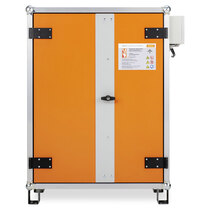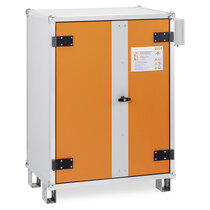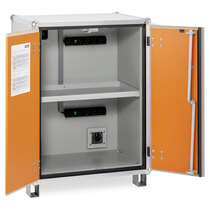-
Contact
Sales & Customer Service
0800 612 6537 support@safelincs.co.uk Live ChatDelivery Enquiries
0800 077 6149 - Resources
Fire & Safety Solutions
CALL OUR TEAM NOW 0800 612 6537
Lines open today 8:30am - 5pm
FREE Delivery
on this product
Live Chat - Online
Instant help & Advice
Trade Discounts
and exclusive pricing
0% Credit Available
Open an account now
5 Star Customer Feedback
Premium Plus Storage and Charging Large Cabinet - CEMO LockEX
Product Overview
Technical Data
FAQs (4)
The large premium plus storage and charging cabinet, from the manufacturer CEMO, is suitable for commercial and industrial use. Featuring CEMO lockEX hinges, these cabinets are designed to withstand the explosive force associated with lithium battery fires and contain the fire, reducing the risk of fire to other business assets. Suitable for the storage and charging of many rechargeable lithium devices with a 6 socket power strip fitted internally. Charging of such devices is disrupted in the event the doors are opened, or if a malfunction or accident occurs.
- Ideal for charging and storing laptops, power tools, and gardening equipment
- Power supply by 2 x 6-way socket power strips
- Fitted with an internal temperature display
- Internal fan aids dissipatation of the heat during charging in the cabinet
- Unique lockEX hinges allow for the explosive pressure to dissipate if an explosion happens
- Charging stops if there is a malfunction, or an accident occurs
- Interrupted charging current when the doors are open
- 60 minute fire resistance from inside to outside
- Supplied with an internal smoke detector (non-audible alarm) to be connected to a fire alarm panel
- Data transmission by the included SIM card:
- Remote access to activate manual mode and stop the charging process
- Query the system status to receive information about temperature and alarm messages
- Dimensions (HxWxD):
- External: 1110 x 660 x 890mm
- Internal: 880 x 530 x 730mm
- The cabinets can be placed under a work bench or are stackable
- Supplied with stacking feet as standard
Please Note: The overall external height increases by 40mm when supplied with castors.
Please Note: The cabinet listed is supplied with 1-phase power supplies. If there is a greater current requirement for your charging needs, there is also a 3-phase power supply available. Please contact our customer service team for pricing and availability.
| Product Code |
Stacking Feet: CEPP8/10F Castors: CEPP8/10C |
|---|---|
| Brand | CEMO |
| External Dimensions (HxWxD) | Stacking Feet: 1110 x 660 x 890mm Castors: 1150 x 660 x 890mm |
| Internal Dimensions (HxWxD) | 880 x 530 x 730mm |
| Number of Sockets | 12 |
| Weight | Stacking Feet: 135kg Castors: 146kg |
| Product Datasheets |
Q. Do lithium-ion batteries explode?
A.
Yes, they can explode! Lithium-ion batteries can explode due to a chain reaction call thermal runaway. This occurs when the battery rapidly increases in temperature, usually from overcharging, exposure to extreme temperatures or moisture, or damage to the cells. Once thermal runaway begins, it will cause an internal fire in the casing which causes a build-up of toxic gases. The pressure eventually causes an explosive reaction.
Generally, lithium-ion batteries are safe to use and charge regularly, as long as they are not damaged, overcharged, or defective.
Q. How do lithium-ion batteries work?
A.
Lithium-ion batteries work by moving lithium-ions between the negative side (Anode) and positive side (Cathode), which creates an electrical current. When charging, lithium-ions move from the cathode to the anode and whilst discharging it is opposite. When the lithium-ions move during a discharge, an electrical current is created and this is what powers the device.
Q. How do you stop a lithium-ion fire?
A.
Stopping a lithium-ion fire is almost impossible due to the ferocity and unpredictable nature of these types of fires. Instead of stopping a fire, it is recommended that preventative measures are taken to ensure that a fire doesn't start. Fireproof charging and storage cabinets are an ideal solution for ensuring that all lithium-ion batteries can be charged and stored safely, even if a fire broke out. These cabinets are designed to contain the fire inside, preventing it from spreading externally.
General advice from the Fire & Rescue Service is to evacuate and get to a place of safety in the event of a lithium-ion fire. Once at a place of safety, call the emergency services and do not attempt to tackle the fire.
Q. What is the difference between a lithium battery and a lithium-ion battery?
A.
Lithium-ion batteries are rechargeable whereas lithium batteries are not. Lithium batteries are more commonly found in products that require long-term, low-power use such as smoke detectors. Lithium-ion batteries are commonly found in items that require recharging frequently such as mobile phones and laptops. Lithium batteries are made up of pure lithium metal, whereas lithium-ion batteries are made up of active materials, such as lithium cobalt oxide (LiCoO2), and do not contain pure lithium metal.
Pricing & Availability
| Model | Stock | Price |
|---|---|---|
|
Stacking Feet Product Code: CEPP8/10F |
Stock Level:
Available for pre-order Expected dispatch: 8th May
|
Price:
£5,476.80 inc VAT £4,564.00 ex VAT |
|
Castors Product Code: CEPP8/10C |
Stock Level:
Available for pre-order Expected dispatch: 8th May
|
Price:
£5,805.60 inc VAT £4,838.00 ex VAT |
Delivery Options
The following delivery options are available on this product.
Looking for more information?
If you have any questions or would like more information about this product you can ask one of our specialists.
Live Chat Available Now
Direct Telephone
01507 464186





























